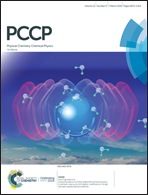The influence of nitrogen position on charge carrier mobility in enantiopure aza[6]helicene crystals†
Abstract
The properties of an organic semiconductor are dependent on both the chemical structure of the molecule involved, and how it is arranged in the solid-state. It is challenging to extract the influence of each individual factor, as small changes in the molecular structure often dramatically change the crystal packing and hence solid-state structure. Here, we use calculations to explore the influence of the nitrogen position on the charge mobility of a chiral organic molecule when the crystal packing is kept constant. The transfer integrals for a series of enantiopure aza[6]helicene crystals sharing the same packing were analysed in order to identify the best supramolecular motifs to promote charge carrier mobility. The regioisomers considered differ only in the positioning of the nitrogen atom in the aromatic scaffold. The simulations showed that even this small change in the chemical structure has a strong effect on the charge transport in the crystal, leading to differences in charge mobility of up to one order of magnitude. Some aza[6]helicene isomers that were packed interlocked with each other showed high HOMO–HOMO integrals (up to 70 meV), whilst molecules arranged with translational symmetry generally afforded the highest LUMO–LUMO integrals (40–70 meV). As many of the results are not intuitively obvious, a computational approach provides additional insight into the design of new semiconducting organic materials.
![Graphical abstract: The influence of nitrogen position on charge carrier mobility in enantiopure aza[6]helicene crystals](/en/Image/Get?imageInfo.ImageType=GA&imageInfo.ImageIdentifier.ManuscriptID=C8CP07603K&imageInfo.ImageIdentifier.Year=2019)


 Please wait while we load your content...
Please wait while we load your content...